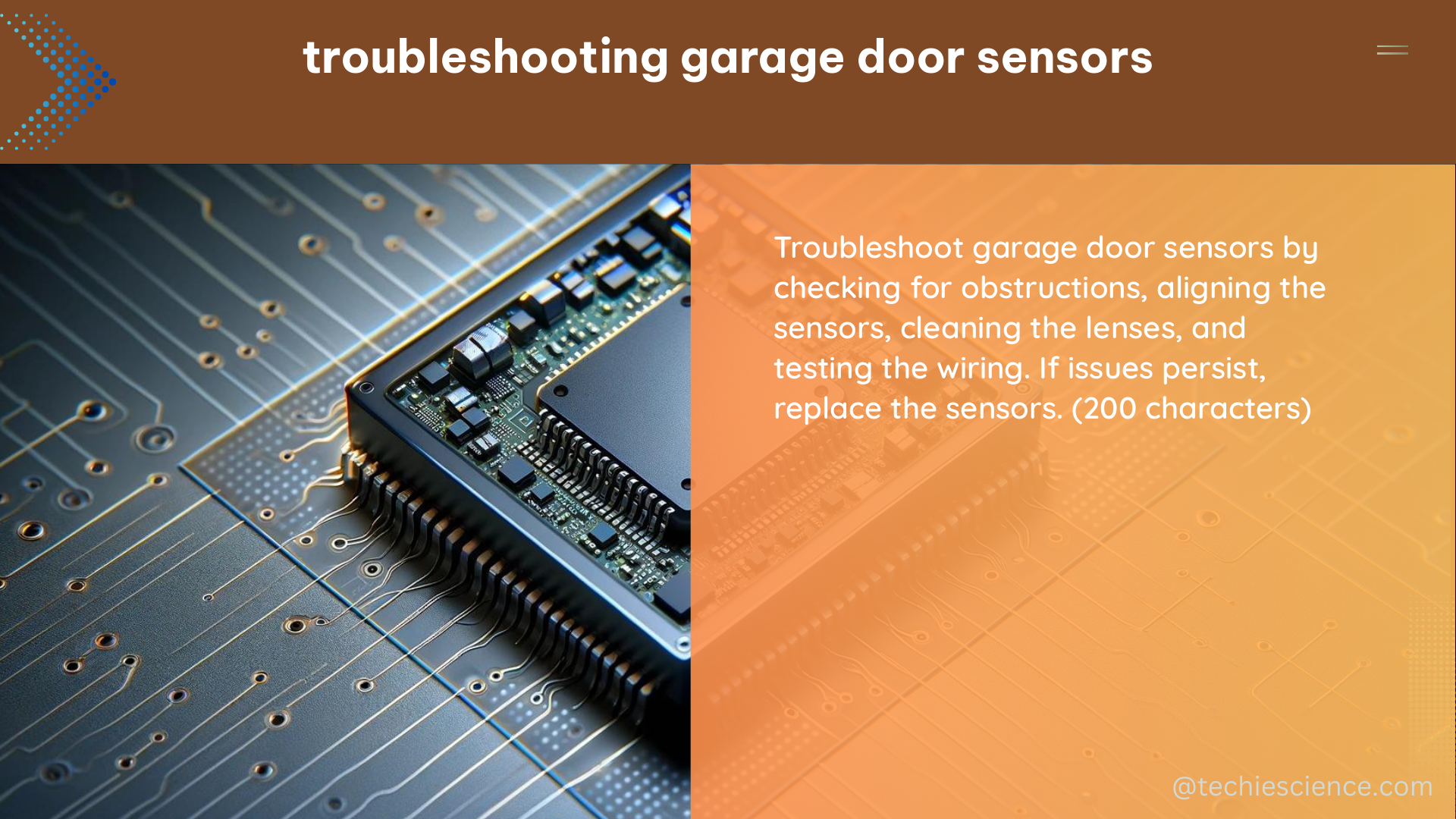Garage door sensors are a critical safety feature that prevent the door from closing on people or objects. However, when these sensors malfunction, it can be a frustrating and potentially dangerous situation. This comprehensive guide will walk you through the step-by-step process of troubleshooting garage door sensors, providing you with the necessary technical details and quantifiable data points to ensure your garage door operates safely and efficiently.
Sensor Alignment
Proper alignment of the garage door sensors is crucial for their proper functioning. The sensors must be facing each other directly, with the LED lights on both sensors illuminated. This can be measured and verified using the following steps:
- Sensor Positioning: The sensors should be mounted on the wall or floor, with one sensor on each side of the garage door opening. The distance between the sensors should be no more than 6 inches (15 cm) from the floor.
- LED Indicator Lights: Ensure that the LED indicator lights on both sensors are illuminated when the garage door is open. If the lights are not illuminated, it may indicate a misalignment issue.
- Sensor Angle: The sensors should be angled slightly downward, with a recommended angle of 15 to 30 degrees from the horizontal plane. This ensures that the sensors are properly aimed at each other.
- Sensor Adjustment: If the sensors are misaligned, use a screwdriver to loosen the mounting screws and adjust the sensor position. Tighten the screws once the sensors are properly aligned, and verify that the LED lights are illuminated.
Wiring Inspection

The wiring of the garage door sensors is another critical component that must be checked during the troubleshooting process. Use a multimeter to measure the voltage across the sensor wires, following these steps:
- Voltage Measurement: With the garage door open, use a multimeter to measure the voltage across the sensor wires. The expected voltage should be between 24-36 VDC.
- Wiring Continuity: If there is no voltage present, check the wiring for any breaks or damage. Use the multimeter to test the continuity of the wires, ensuring that there are no breaks or shorts in the circuit.
- Wiring Replacement: If the wiring is damaged, replace the affected section with new, properly-rated wiring. Ensure that all connections are secure and that the voltage is within the expected range.
Sensor Functionality Testing
To verify the functionality of the garage door sensors, follow these steps:
- Obstruction Test: Place an object, such as a piece of wood or a broom handle, in the path of the sensors. Attempt to close the garage door, and observe whether the door stops and reverses its direction.
- Sensor Response Time: The sensors should detect the obstruction and cause the door to stop and reverse within 1-2 seconds. If the door takes longer to respond or does not reverse, the sensors may need to be replaced.
- Sensor Replacement: If the sensors are not functioning properly, replace them with new, compatible sensors. Ensure that the new sensors are properly aligned and that the wiring is in good condition.
Potential Obstructions
In addition to the sensor alignment and wiring, it’s important to check for any potential obstructions that may be interfering with the sensor’s operation. Follow these steps:
- Sensor Path Inspection: Visually inspect the path between the two sensors, ensuring that there are no objects or debris that could be blocking the sensor’s infrared beam.
- Sensor Lens Cleaning: Clean the sensor lenses using a soft, dry cloth to remove any dirt or dust that may have accumulated over time.
- Sensor Mounting Height: Ensure that the sensors are mounted at the recommended height of 6 inches (15 cm) from the floor. Obstructions at this height can interfere with the sensor’s operation.
Best Practices for Maintenance
To ensure the long-term reliability and performance of your garage door sensors, follow these best practices for maintenance:
- Regular Cleaning: Clean the sensor lenses on a monthly basis using a soft, dry cloth to remove any dirt or debris.
- Physical Inspection: Visually inspect the sensors for any physical damage, such as cracks or breaks, and replace them if necessary.
- Sensor Alignment Verification: Periodically check the sensor alignment and adjust as needed to ensure proper operation.
- Wiring Inspection: Regularly inspect the sensor wiring for any signs of damage or wear, and replace the wiring if necessary.
- Sensor Replacement: Replace the sensors every 5-7 years, or as recommended by the manufacturer, to ensure optimal performance and safety.
By following this comprehensive guide, you’ll be able to effectively troubleshoot and maintain your garage door sensors, ensuring the safe and reliable operation of your garage door system.
References
- Troubleshooting Garage Door Sensors
- Guide to Garage Door Safety Sensors: Testing Garage Door Safety Sensors
- How to Troubleshoot Garage Door Sensors

The lambdageeks.com Core SME Team is a group of experienced subject matter experts from diverse scientific and technical fields including Physics, Chemistry, Technology,Electronics & Electrical Engineering, Automotive, Mechanical Engineering. Our team collaborates to create high-quality, well-researched articles on a wide range of science and technology topics for the lambdageeks.com website.
All Our Senior SME are having more than 7 Years of experience in the respective fields . They are either Working Industry Professionals or assocaited With different Universities. Refer Our Authors Page to get to know About our Core SMEs.